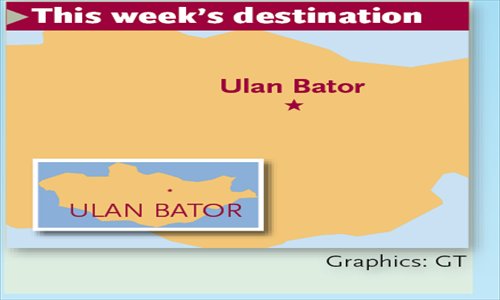
Call of the wild
The next morning, Liz and I took a walk to the lakeside for a spot of photography. When we turned back toward the camp, two of the local pack of mastiffs were loping toward us slowly, heads down. After a moment of worry, we stood our ground only to see them run up to us happily, wagging their tails. It turns out these huge dogs just wanted some affection, and they became our constant companions during our stay there. One of them was clearly hurt, half of its jaw ripped off and oozing pus. When we asked Bolor what had happened, he pointed to the mountain behind us and said: "Wolves." We felt slightly bad for nicknaming such beasts Serena and Fluffles, but the names stuck.
The next day saw Bolor and one of the family's sons meet us outside the yurt with horses, ready to take us for a ride to a nearby inactive volcano called Khorgo. This escapade again helped reinforce why Mongolia is a destination like few others. Accompanied by wolf-killing dogs, we rode slowly across a field of volcanic rock and ascended a steep path to the rim before clambering down jagged rocks into the wide crater upon being encouraged by Bolor. Had we been seriously hurt at any point, we would have been in real trouble, likely needing to be rescued by helicopter.
Heading back to the camp, we saw that another van had arrived. A curious figure sat next to one of the yurts, surrounded by the family and some of the neighbors. Dressed in traditional Mongolian garb, the man also sported a shawl of fur straps and reindeer-skin boots. He soon donned a mask and headdress, made of strips of black and yellow cloth, topped with a circlet of eagle feathers. Bolor told us this was a shaman who had been asked to come to read the fortunes of the local families and help cure their illnesses. We asked if we could also consult with the shaman, who agreed, although not without some initial reluctance. When my turn came, he made me kneel before him and bow deeply. Placing his head above mine, he alternated between feeling the back of my skull and hitting various spots on my back, sometimes quite strongly. He made a series of observations in a guttural voice which Bolor, crouching next to us, translated. According to the shaman, I was to forge an enduring connection with Mongolia, one that would last my entire life and see me return.
I don't know if I believe in shamanistic rituals, but after spending just over a week in a land that seems to have remained largely unchanged for a millennia - except for the odd motorbike or battery-powered tool - I concede he may have had a point.
Rules of Thumb
Why go? Mongolia is a rapidly changing country. This long-ignored land is now grabbing the attention of people around the world, and investments are pouring in. Although its culture will withstand the influx of guests, visiting the country in the next couple of years is advisable as mass tourism cannot be far behind.
When to go? Mongolia is cold for many months. From mid-September to early May, the weather makes many parts of the country troublesome, especially after November, when travel is inadvisable. The best period is July, when the Naadam festival sees Mongolians around the country engage in traditional sports such as archery and wrestling. Book early if you want to attend the major Naadam festivities in Ulan Bator, as tickets go very fast.

Copyright ©1999-2011 Chinanews.com. All rights reserved.
Reproduction in whole or in part without permission is prohibited.